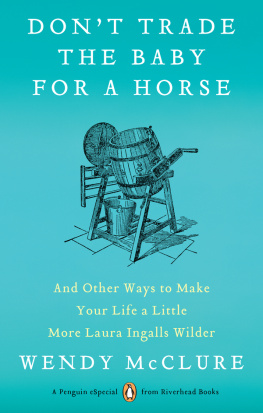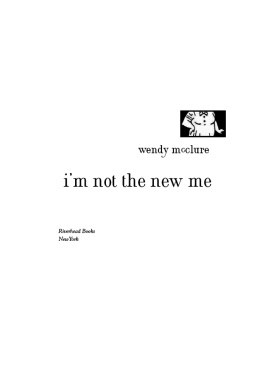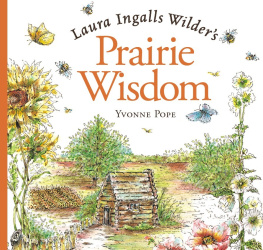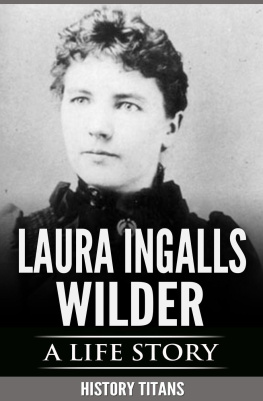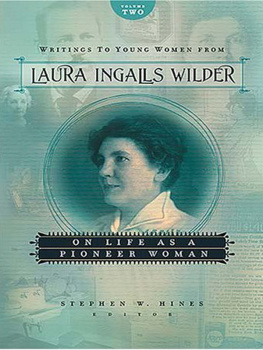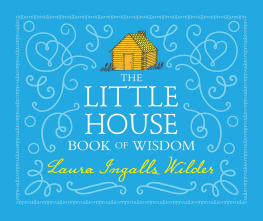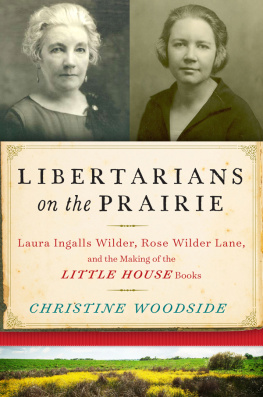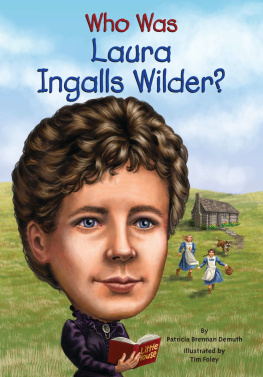Also by Wendy McClure
Im Not the New Me
The Amazing Mackerel Pudding Plan
The Wilder Life
Dont Trade the Baby for a Horse
And Other Ways to Make Your Life a Little More Laura Ingalls Wilder
Wendy McClure
Riverhead Books
New York
Contents
RIVERHEAD BOOKS
Published by the Penguin Group
Penguin Group (USA) Inc., 375 Hudson Street, New York, New York 10014, USA
Penguin Group (Canada), 90 Eglinton Avenue East, Suite 700, Toronto, Ontario M4P 2Y3, Canada (a division of Pearson Penguin Canada Inc.)
Penguin Books Ltd, 80 Strand, London WC2R 0RL, England
Penguin Ireland, 25 St Stephens Green, Dublin 2, Ireland (a division of Penguin Books Ltd)
Penguin Group (Australia), 250 Camberwell Road, Camberwell, Victoria 3124, Australia
(a division of Pearson Australia Group Pty Ltd)
Penguin Books India Pvt Ltd, 11 Community Centre, Panchsheel Park, New Delhi110 017, India
Penguin Group (NZ), 67 Apollo Drive, Rosedale, Auckland 0632, New Zealand (a division of Pearson New Zealand Ltd)
Penguin Books (South Africa) (Pty) Ltd, 24 Sturdee Avenue, Rosebank, Johannesburg 2196, South Africa
Penguin Books Ltd, Registered Offices: 80 Strand, London WC2R 0RL, England
While the author has made every effort to provide accurate telephone numbers and Internet addresses at the time of publication, neither the publisher nor the author assumes any responsibility for errors, or for changes that occur after publication. Further, the publisher does not have any control over and does not assume any responsibility for author or third-party websites or their content.
A Riverhead eSpecial / published by arrangement with the author
Copyright 2012 by Wendy McClure
All rights reserved.
No part of this book may be reproduced, scanned, or distributed in any printed or electronic form without permission. Please do not participate in or encourage piracy of copyrighted materials in violation of the authors rights. Purchase only authorized editions.
RIVERHEAD and its logo are registered trademarks of Penguin Group (USA) Inc .
PUBLISHING HISTORY
Riverhead Books eSpecial / April 2012
ISBN: 978-101-57973-2
Penguin is committed to publishing works of quality and integrity.
In that spirit, we are proud to offer this book to our readers;
however, the story, the experiences, and the words
are the authors alone.

INTRODUCTION
The Little House series by Laura Ingalls Wilder are the kind of books you first read when youre about eight, then reread every few years throughout your teen years and into your adulthood, until the books start to fall apart. Maybe youve taped up the binding, or perhaps youve been searching for a replacement set of the yellow Harper Trophy paperbacks on eBay. (Maybe you tried to see if you could score them as ebooks and you found this book instead.)
I understand. We need those bookseach one a portal into the world of clean-swept log cabins and neatly made trundle beds. We always want to go back and find our place againthat place in the center of the circle of prairie, where we sit in the covered wagon and ride with Laura and Mary. Its always there.
Whenever we go back again, we find something differentsome wisdom that hadnt chimed with us before but now rings true to our current lives. When we were kids we learned that it was better not to fill your pockets with pebbles or jump up and down on a yellow-jacket nest. Perhaps in our teens we learned to appreciate the kind of guy who would give you rides home across the icy prairie without expecting a commitment (or even the tiniest hickey) in return.
Other notable lessons from the books include:
Least said, soonest mended.
Itll never be noticed on a trotting horse.
Dont give pulled candy to a pig.
Dont poke badgers with sticks.
Dont establish an illegal homestead on Osage Diminished Reserve Lands.
Dont slide down the straw-stack.
Dont roll down it, either.
While some bits of knowledge havent withstood the test of time (What was that business about the night air being unhealthy? Were you just supposed to not breathe at night?), many more of them are relevant in ways I continue to discover. The older I get, the more these books yield up to me.
Back in 2008, I reread the books for the first time in about thirty years. Not long after that, and for the next two years, I embarked on what you might call a crash course in Lauraologyreading everything I could about the Little House novels and the remarkable lives of their authors (I believe Laura wrote in collaboration with her daughter Rose and that neither could have written the books on her own). I took it upon myself to churn butter and try some of the recipes in The Little House Cookbook. I went to the all the places where Laura and her family lived, and I wrote my book The Wilder Life about my experiences.
There were only replicas where the log cabins and houses had stood, but for the most part the landscapes hadnt changed; I saw Lake Pepin, Plum Creek, the Big Slough; I saw and understood them as real places. Yet for all this reality, the world inside the books never diminished for me. I still loved the charcoal-sketched horizon that Garth Williams drew across the spread pages of The Little House on the Prairie. And while I have photos now, and souvenirs (lake pebbles, a corn cob doll, and an alarming number of sunbonnets), the stories have stayed with me, too. Theyre woven into my consciousness; they deploy tiny recollections that speak to my present moments. Ill hear Mas voice, or Pas, or Lauras, or the patient, faceless narrator who lives inside my head. They all tell me things I need to know and remind me of whats true.
If youre looking for ways to keep the world of the books with you in your everyday lifecarrying it from place to place like Mas china shepherdessthen read on. Fix yourself some cambric tea and Ill tell you more.
SAVOR CANDY
I think in order to really understand what candy meant to Laura Ingalls and her sisters, we have to first imagine a world without chocolate.
Oh, sure, in the 1870s you could get chocolate somewhere as an Old World delicacy. Its possible that Nellie Oleson cherished an old memory of sampling a bonbon or two back in New York. But Laura lived wholly in the new world, where Milton Hershey wouldnt perfect mass-production of chocolate until the turn of the nineteenth century, and thus no one had Hershey Bars, or Godiva truffles, Russell Stover Valentine assortments, or great big waxy one-pound chocolate bunnies. There was no such notion as death by chocolate (probably most folks back then would read the phrase as a bizarre misprint of death bycholera), and nobody professed to be a chocoholic. There were no Raisinets, no Cocoa Puffs, no chocolate-covered bacon.
There were only two kinds of candy: the kind that you had to make at home and storeboughten. To compare them is to confront the essential duality of the Ingalls family lifestyle. For all the rapturous descriptions of Pa building doors by hand, Ma making her own soap, and the children pouring hot sugar syrup into the snow to make candy, there is an equally delighted inventory of the things that come from the town mercantilesporcelain doorknobs, rubber hair combs, and licorice sticks. Both types of things have palpable value, of coursethe manufactured stuff is scarce and the homemade is hard-wonand through Lauras eyes we marvel at

